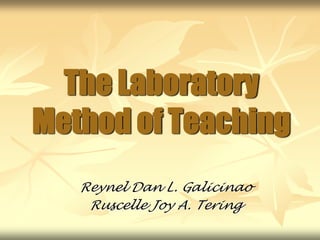The laboratory method of teaching
The laboratory method of teaching utilizes hands-on learning with real objects and data to give students a better understanding of course material. It involves defining a problem, gathering information through observation and experimentation, forming a hypothesis, collecting and analyzing data, and drawing conclusions. The key aspects are learning by doing, using reality instead of symbols, and developing scientific skills like observation, reasoning, and applying the scientific method. Some advantages are that students directly engage with materials, better develop problem-solving abilities, and gain experience that can translate to real-life situations. However, it can be more time-consuming and resource-intensive than other methods of instruction.

Recomendados
Recomendados
Mais conteúdo relacionado
Mais procurados
Mais procurados (20)
Destaque (8)
Semelhante a The laboratory method of teaching
Semelhante a The laboratory method of teaching (20)
Mais de Reynel Dan
Mais de Reynel Dan (20)
The laboratory method of teaching
- 1. The Laboratory Method of Teaching Reynel Dan L. Galicinao Ruscelle Joy A. Tering
- 2. Laboratory Method Utilizes raw data or material things to produce better understanding of the subject matter or lesson Learning by doing Using reality instead of symbols. - reality has more vividness Investigatory or experimental
- 3. Objectives 1. Make use of the power of observation and reasoning 2. Manipulate learning equipments 3. Make use of reality to make learning easier and more permanent 4. Make use of the scientific attitudes 5. Use the laboratory method or procedure
- 4. Advantages Students learn by doing and come in contact with raw data or material objects in the teaching-learning process. Develops the power of observation and reasoning.
- 5. Advantages 3. Develops the scientific attitude. 4. Gives an understanding of what research is and how to apply the scientific method of research
- 6. Advantages 5. Gives training in organizing data gathered from real material objects and how these objects are manipulated to attain the objectives. 6. Since students come in contact with real life situations, it can be a preparation for solving real life problems.
- 7. Disadvantages Uneconomical way of learning in time and material. Does not give much training in verbal expression and when the same equipment is used most of the time, its use becomes mechanical i.e., used without much thinking anymore
- 8. Scientific Method Define the question Gather information and resources (observe) Form hypothesis Perform experiment and collect data Analyze data Interpret data and draw conclusions that serve as a starting point for new hypothesis
- 10. Preparation Review of past lesson relevant to the present for apperception and motivation. Raising and defining the work to be done. Expected learning outcomes.
- 11. Preparation d. Planning. (individually or groups) - what is important is that everyone knows exactly what he is going to do and to do it correctly and timely.
- 12. Actual Work Period Students work under the supervision of the teacher. (Supervised study) Students may work: - individually attacking the same problem or different problems - in groups attacking the same problem - in groups with each group working on a portion, phase or stage of the problem
- 13. Actual Work Period The work may last for a single study period or for days. All works must be recorded for continuity of the task. Those who work fast may be given additional assignment for additional credits. If the work is experimental, no-experimental variables must be constant.
- 14. Culminating Activities Reporting what is worked on by individuals or groups in plenary session of the class. After each report, there is an open forum. Questions, discussions, generalizations, conclusions are made.
- 15. Culminating Activity Different reports may be consolidated into one then photocopies will be given to each member of the class to review and get ready for a test for evaluation.
- 18. Sample of The Laboratory Method of Teaching Vital Signs Taking Preparation: Review on Vital signs Steps in performing vital signs taking Expected Learning Outcomes Planning
- 20. Other Examples COPAR Actual exposure in the Clinical Area Suctioning And in performing other nursing skills
